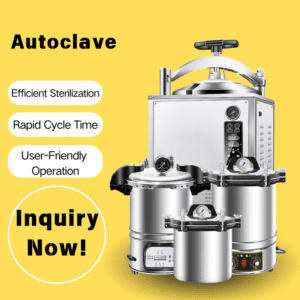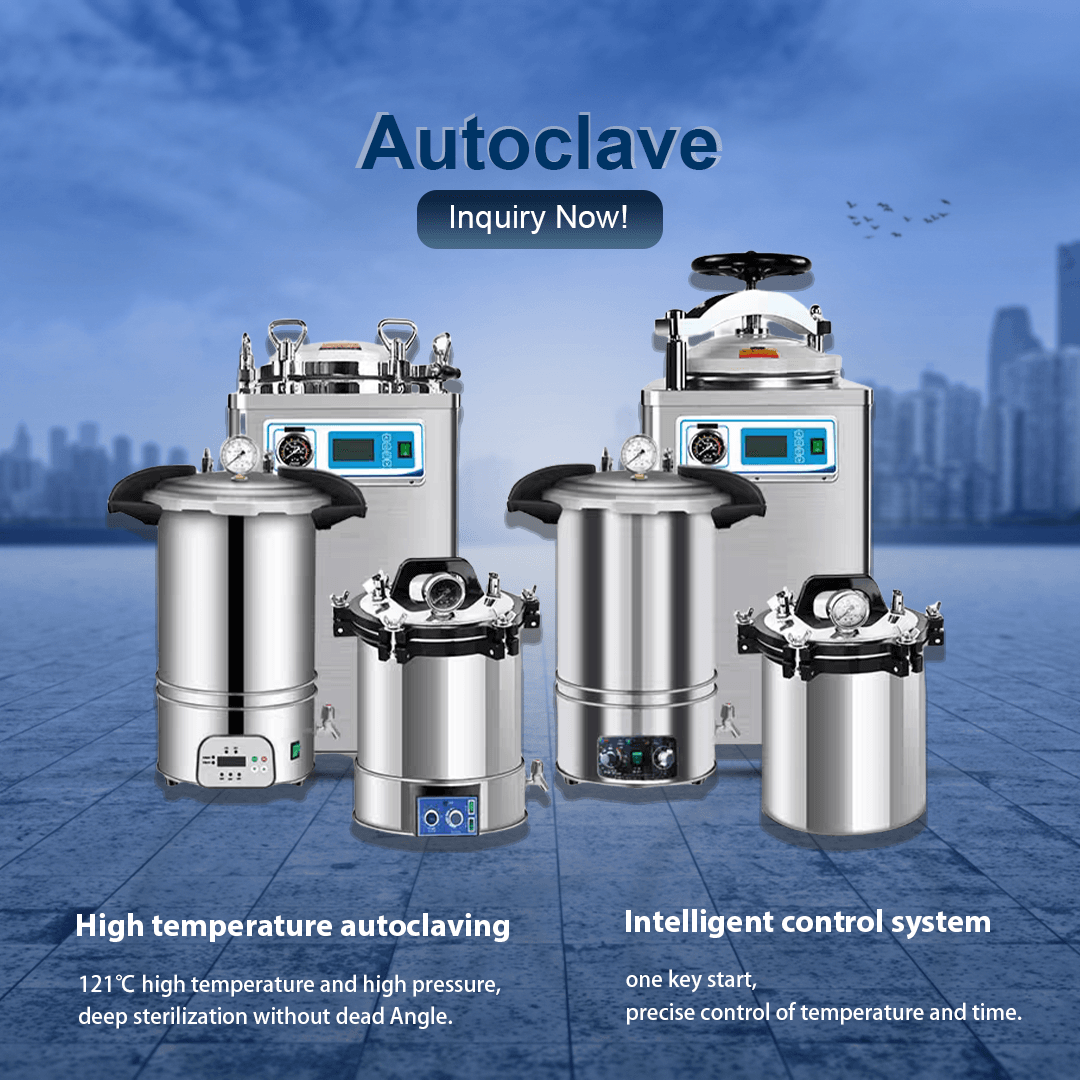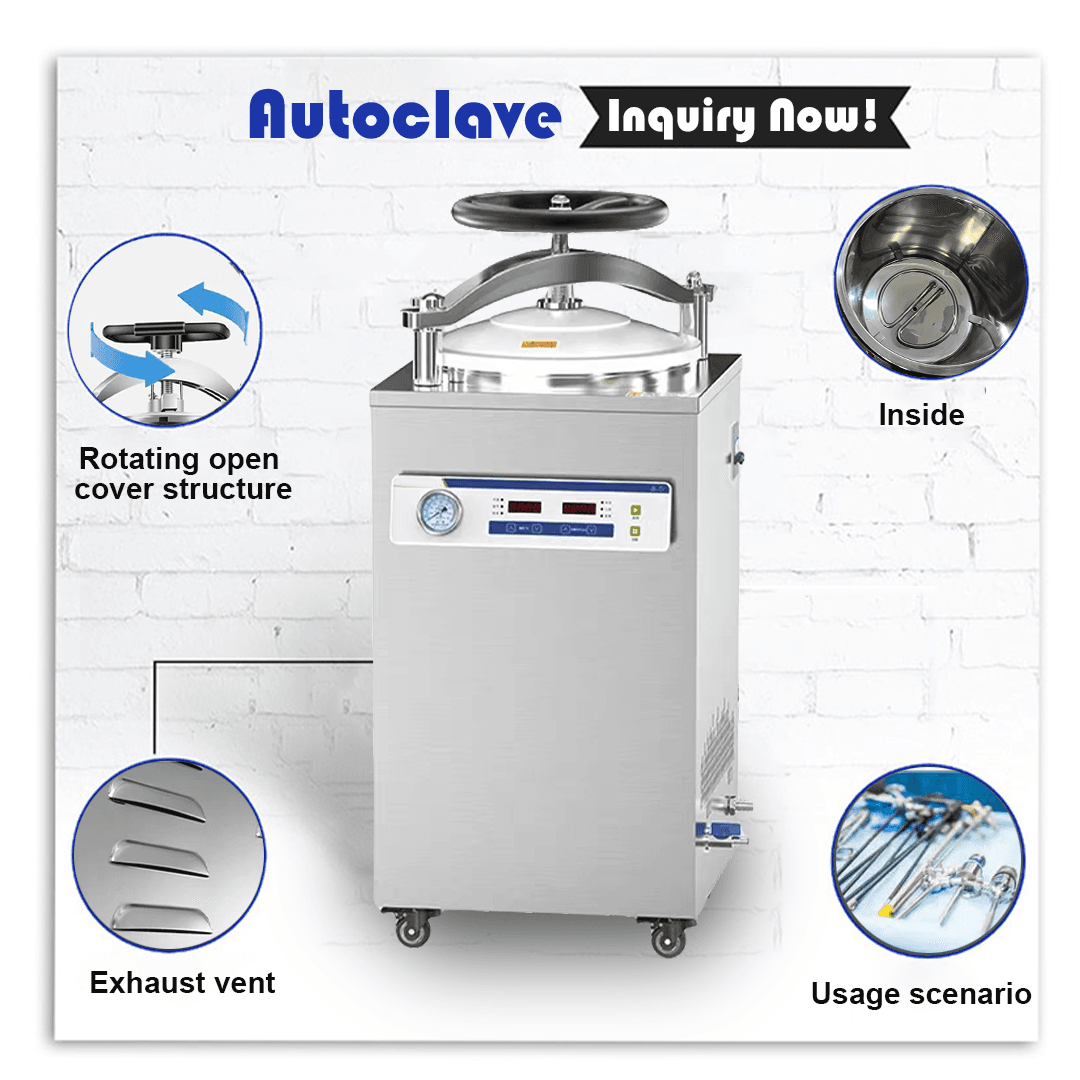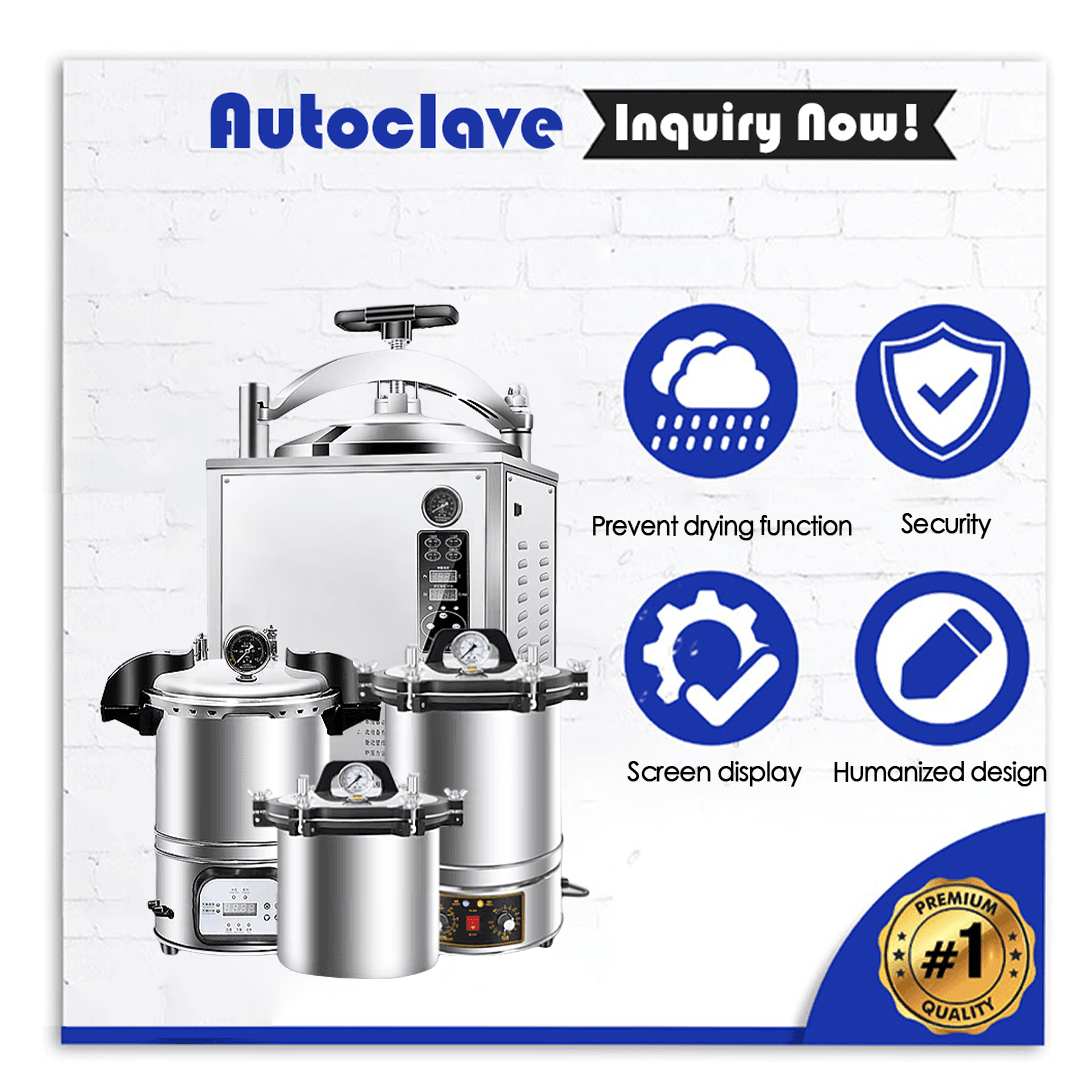
An autoclave sterilizes medical instruments, laboratory tools, and various materials through the application of high-pressure steam at high temperatures. Through this procedure every microorganism including bacteria viruses fungi and even resilient bacterial spores is completely eradicated. Autoclaves maintain healthcare industry cleanliness standards which helps prevent infections during medical and laboratory work.
The primary role of autoclaves as contamination barriers must be understood by medical equipment distributors and procurement professionals to meet healthcare providers’ needs. Autoclaves function as fundamental devices which both help healthcare facilities meet regulatory requirements and ensure patient protection.
Autoclaves function by utilizing moist heat to achieve sterilization. Under pressure the autoclave generates steam temperatures which exceed boiling water levels reaching 121°C (250°F) or 134°C (273°F) for a predetermined time. The combination of heat with pressure and time works to denature microorganism proteins which consequently inactivates them and achieves full sterilization. The pressurized conditions inside the chamber enable steam to reach all areas within porous materials and complex instrument designs to ensure complete sterilization.
Successful sterilization in an autoclave requires multiple stages where each one plays an essential role for obtaining the intended results.
During the Purging Phase the autoclave chamber is cleared of air which enables steam to penetrate sterilizing items completely. Certain autoclave models utilize vacuum systems to improve the air removal process.
Steam enters the chamber at controlled temperature and pressure settings where it remains for a designated duration to eradicate all microbial life.
The chamber releases pressure after sterilization to cool and dry items which prevents moisture accumulation that might cause recontamination.
Distributors can demonstrate the autoclave sterilization system’s dependability and comprehensive nature to their customers by teaching them about each stage which strengthens its worth in medical environments.
The proper functioning of an autoclave depends on multiple essential components working together.
The sterilization process requires placing items into a sealed chamber that prevents contamination.
The Steam Generator functions by heating water to create high-temperature steam.
The Pressure System sustains required pressure levels to create proper sterilization environments.
The Control Unit provides operators the ability to both set and monitor important variables such as temperature levels alongside pressure settings and cycle lengths.
The autoclave’s safety mechanisms consist of pressure relief valves and automatic shut-off features to protect both users and the equipment.
Expert knowledge of these components helps procurement specialists choose autoclave models that perfectly match healthcare facilities’ operational requirements.
The primary function of an autoclave is to sterilize surgical and medical instruments. Surgeons need to use scalpels, forceps, and scissors that have been sterilized to eliminate pathogens and prevent infections after operations. Autoclaves achieve the strictest sterility requirements for medical instruments which makes them essential equipment in hospitals and surgical centers.
Research and diagnostic labs utilize autoclaves to sterilize tools including pipettes and glassware. The sterilization process keeps experimental contamination from occurring which leads to accurate and dependable results. Distributors who sell to laboratories should highlight how autoclaves help preserve experimental integrity as a powerful sales argument.
The management of biohazardous waste relies on autoclaves to perform essential sterilization functions. Sterilizing contaminated items like dressings and disposable instruments before disposal helps prevent infection transmission. Healthcare facilities producing large amounts of waste can benefit from autoclave technology which allows vendors to demonstrate product flexibility.
Autoclaves play an essential role in dental clinics and veterinary practices where they sterilize tools and equipment needed for patient care. Healthcare settings such as dental offices and veterinary practices prefer compact autoclave models and distributors meet this need by providing various sizes and configurations.
Autoclaves protect patients by using their sterilization capabilities to eliminate harmful pathogens from medical equipment. Autoclaves effectively reduce the risk of severe healthcare setting infections by sterilizing medical equipment. Distributors should highlight this benefit while selling to healthcare facilities that prioritize patient care results.
Healthcare professionals must adhere to rigorous standards for sterilization and hygiene. Autoclaves help facilities adhere to mandatory standards to avoid penalties and preserve their operational licenses. Procurement professionals depend on supplying equipment that maintains compliance as their main value proposition.
Although purchasing an autoclave requires a substantial initial investment it ultimately provides financial benefits by decreasing the need for single-use instruments and lowering costs related to infections. Autoclave distributors can attract clients focused on budget savings by demonstrating long-term economic advantages of autoclave utilization.
An autoclave proves its versatility through multiple applications which include sterilizing instruments and laboratory materials as well as medical waste disposal. The ability of autoclaves to meet multiple requirements makes them attractive to various healthcare providers which enables distributors to market them as essential equipment for diverse medical settings.
Specific facilities can achieve optimal autoclave performance through the appropriate chamber size and design features. High-volume hospitals require larger autoclave models compared to smaller units which work best for clinics with space constraints. Distributors need to evaluate client requirements before suggesting the correct autoclave equipment size.
Operational workflows are impacted by how long an autoclave takes to finish its sterilization cycle. Medical facilities that process large numbers of instruments daily often choose autoclave models that feature faster sterilization cycles. Procurement specialists need to understand cycle efficiency to properly select autoclaves that meet client needs.
The temperature and pressure settings necessary for sterilization must be tailored to suit the specific requirements of different materials and items. Adjustable parameter features in autoclaves provide enhanced flexibility which distributors should promote to facilities that have diverse sterilization requirements.
Autoclave performance depends on both routine maintenance and comprehensive operator training. Regular maintenance provides reliable performance results while properly trained personnel can handle equipment operation both securely and efficiently. Distributors provide added value through maintenance support and training resources.
Smaller healthcare providers face financial challenges when buying an autoclave because of its high cost. To overcome the initial investment hurdle distributors can present financing solutions or demonstrate how autoclave sterilization saves money over time.
Compact facilities might struggle to accommodate larger autoclave models because they require extensive space. Clients with limited space can find solutions by choosing from a variety of autoclave sizes which include both portable and benchtop units.
A number of autoclave models feature complicated control systems and necessitate expert operational knowledge. Distributors provide clients with easier-to-use options or training assistance to ensure correct operation of autoclave equipment.
Autoclave technology progresses with new innovations that enhance their operational efficiency and function. Emerging trends include:
Modern autoclaves feature designs optimized to minimize both water usage and power consumption while meeting sustainability objectives.
Autoclaves that include smart monitoring and remote operation capabilities are becoming popular since they provide better control and user convenience.
Advanced technologies enable shorter sterilization times while maintaining effectiveness in high-demand environments.
Distributors who keep up with these advancements establish themselves as advanced suppliers who can satisfy future client needs.
Autoclaves serve as essential sterilization equipment which protects healthcare environments through safety and hygiene maintenance. Autoclaves apply high-pressure steam to destroy pathogens which guarantees that medical devices, laboratory apparatus, and biohazardous materials remain infection free. Medical equipment distributors and procurement professionals must understand sterilization functions to supply hospitals and clinics with solutions that meet strict requirements. The medical supply chain industry stands to benefit from new opportunities as autoclave technology progresses to become both more efficient and versatile. Reach out to us for reliable autoclave solutions and learn how they can benefit your clients. Reach out via [inquiry@shkeling.com](mailto: Send your inquiries to inquiry@shkeling.com or get in touch through WhatsApp at +8618221822482 and check our range of products at https://autoclaveequipment.com/. Our team stands prepared to guide you towards the ideal sterilization equipment solutions that will boost your business operations and provide support to healthcare professionals.
1. An autoclave operates to sterilize healthcare tools and laboratory devices by applying high-pressure steam to kill all bacteria and viruses. Autoclaves sterilize medical instruments and laboratory equipment by using high-pressure steam to destroy pathogens and stop infections.
2. How does an autoclave ensure complete sterilization? The autoclave achieves complete sterilization by applying high temperature and pressure with steam for a specific period to eliminate all microbes including hardened spores.
3. Autoclaves can purify heat-tolerant tools including surgical implements and glassware besides selected hazardous waste products. Surgical instruments, glassware, and certain biohazardous waste are sterilized by autoclaves because they endure both heat and moisture. Always check compatibility guidelines for specific materials.
4. Autoclaves maintain healthcare compliance because their sterilization capabilities help facilities meet regulatory standards for infection control while protecting patient safety. Autoclaves achieve sterility which allows healthcare facilities to meet rigorous infection control regulations and protect patients while preventing penalty risks.
5. The frequency of autoclave usage in medical facilities depends on operational needs but usually occurs daily for settings with regular procedures or experiments. While the frequency of autoclave use varies according to each facility’s specific needs, daily operation of autoclaves is common in environments with regular procedures and experiments to ensure sterilization of equipment and materials.
6. Medical equipment distributors benefit from offering autoclaves because they fulfill essential sterilization demands while building customer trust and capturing a key healthcare market segment. By providing autoclaves distributors fulfill an essential requirement for sterilization tools and establish client trust and market presence in healthcare.

Healthcare facilities must adhere to rigorous hygiene and sterilization standards without exception. Medical equipment distributors and procurement professionals must understand the tools that maintain standards to deliver value to healthcare

Maintaining sterile medical tools and equipment stands as the most important practice for preventing infections and ensuring patient safety in healthcare settings. Medical equipment distributors along with dealers and procurement

The fast-paced healthcare sector operates under strict regulations which demand that sterility maintenance stands as a primary concern to protect patient safety and ensure compliance with operational standards. Medical equipment

Sterilization equipment serves as an essential tool in healthcare settings to maintain cleanliness standards and protect patients. Medical equipment distributors together with dealers and procurement specialists need to know the

Autoclaves serve as essential components of sterilization processes in healthcare facilities through high-pressure steam to destroy pathogens on medical instruments and other materials. Medical equipment distributors and procurement specialists must

Healthcare environments must prioritize sterilization because it protects patients and staff by removing infectious pathogens from medical devices and materials. The autoclave stands out as one of the best tools